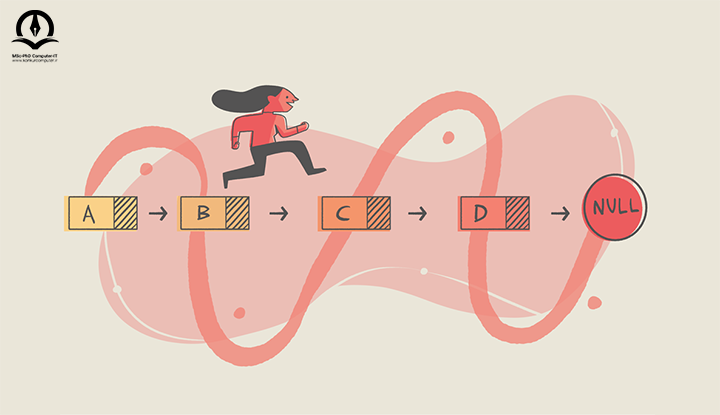برای شروع حرفهای کنکور ارشد کامپیوتر،آیتی و علوم کامپیوتر حتما روی عکس زیر کلیک کنید تا در کانال کنکور کامپیوتر عضو شوید، در این کانال به معرفی بهترین منابع کنکور ارشد،برنامه ریزی و مشاوره، معرفی گرایشها و هر آنچه برای موفقیت در کنکور ارشد نیاز دارید پرداخته شده است

عملیات لیست پیوندی مختلفی وجود دارد که به ما امکان میدهد اقدامات مختلفی را در لیست های پیوندی انجام دهیم. بهعنوانمثال، عملیات درج، یک عنصر جدید به لیست پیوند شده اضافه میکند. عملیاتی که در این مقاله به بررسی آنها خواهیم پرداخت شامل موارد زیر میشود:

- درج: یک عنصر جدید به لیست پیوند شده اضافه میکند.
- حذف: عناصر موجود را حذف میکند.
- جستجو: یک گره را در لیست پیوندی پیدا میکند.
درج در لیست پیوندی
میتوان عناصر را به ابتدا، وسط یا انتهای لیست پیوند داده شده اضافه کرد.
درج در ابتدای لیست پیوندی
مراحل موردنیاز برای درج عنصر در ابتدای لیست پیوندی بهصورت زیر است:
- تخصیص حافظه برای گره جدید
- ذخیره دادهها
- تغییر اشارهگر Next گره جدید، به گره Head
- تعیین گره جدید بهعنوان گره Head
پیادهسازی این مراحل به شکل زیر است:
struct node *newNode;
newNode = malloc(sizeof(struct node));
newNode->data = 4;
newNode->next = head;
head = newNode;
درج در انتهای لیست پیوندی
مراحل موردنیاز برای درج عنصر در انتهای لیست پیوندی بهصورت زیر است:
- تخصیص حافظهحافظه در کامپیوتر، همه چیز در مورد حافظه در معماری کامپیوتر
 در این مقاله به بررسی کامل حافظه در کامپیوتر، انواع حافظه در کامپیوتر، کش، روشهای آدرس دهی کش، نگاشت آدرس و موارد دیگر میپردازیم برای گره جدید
در این مقاله به بررسی کامل حافظه در کامپیوتر، انواع حافظه در کامپیوتر، کش، روشهای آدرس دهی کش، نگاشت آدرس و موارد دیگر میپردازیم برای گره جدید - ذخیره دادهها
- پیمایش لیست پیوندی تا آخرین گره
- تغییر اشارهگر Next آخرین گره، به گرهایی که اخیراً ایجاد شده است.
پیاده سازی این مراحل به شکل زیر است:
struct node *newNode;
newNode = malloc(sizeof(struct node));
newNode->data = 4;
newNode->next = NULL;
struct node *temp = head;
while(temp->next != NULL){
temp = temp->next;
}
temp->next = newNode;
درج در وسط لیست پیوندی
مراحل موردنیاز برای درج عنصر در وسط لیست پیوندی بهصورت زیر است:
- تخصیص حافظهحافظه در کامپیوتر، همه چیز در مورد حافظه در معماری کامپیوتر
 در این مقاله به بررسی کامل حافظه در کامپیوتر، انواع حافظه در کامپیوتر، کش، روشهای آدرس دهی کش، نگاشت آدرس و موارد دیگر میپردازیم و ذخیره دادهها برای گره جدید
در این مقاله به بررسی کامل حافظه در کامپیوتر، انواع حافظه در کامپیوتر، کش، روشهای آدرس دهی کش، نگاشت آدرس و موارد دیگر میپردازیم و ذخیره دادهها برای گره جدید - حرکت به گره قبل از موقعیت موردنیاز گره جدید
- تغییر اشارهگرهای Next، تا گره جدیدی در بین آنها قرار گیرد.
پیادهسازی این مراحل به شکل زیر است:
struct node *newNode;
newNode = malloc(sizeof(struct node));
newNode->data = 4;
struct node *temp = head;
for(int i=2; i < position; i++) {
if(temp->next != NULL) {
temp = temp->next;
}
}
newNode->next = temp->next;
temp->next = newNode;
عملیات حذف در لیست پیوندی
میتوان از ابتدا، انتها یا از یک موقعیت خاص حذف کرد.
حذف از ابتدای لیست پیوندی
تنها مرحله موردنیاز برای حذف عنصر از ابتدای لیست پیوندی بهصورت زیر است:
- تغییر اشارهگرHead به سمت گره دوم
پیادهسازی آن بهصورت زیر است:
head = head->next;
حذف از انتهای لیست پیوندی
مراحل موردنیاز برای حذف عنصر از انتهای لیست پیوندی بهصورت زیر است:
- پیمایش لیست پیوندی تا عنصر یکی مانده به آخر.
- تغییر اشارهگر Next آن گره به Null.
پیادهسازی این مراحل به شکل زیر است:
struct node* temp = head;
while(temp->next->next!=NULL){
temp = temp->next;
}
temp->next = NULL;
حذف از وسط لیست پیوندی
مراحل موردنیاز برای حذف عنصر از وسط لیست پیوندی بهصورت زیر است:
- پیمایش تا قبل از عنصری که باید حذف شود.
- تغییر اشارهگر Next آن گره به گره بعد از گرهی که باید حذف شود.
پیادهسازی این مراحل به شکل زیر است:
for(int i=2; i< position; i++) {
if(temp->next!=NULL) {
temp = temp->next;
}
}
temp->next = temp->next->next;
عملیات جستجو در لیست پیوندی
با استفاده از مراحل زیر میتوان یک عنصر را در یک لیست پیوندی با استفاده از یک حلقه جستجو کرد.
- گره Head را به عنوان گره فعلی انتخاب کنید.
- یک حلقه را اجرا کنید تا گره فعلی NULL شود، زیرا آخرین عنصر به NULL اشاره میکند.
- در هر پیمایش، بررسی کنید که آیا کلید گره برابر با آیتم موردنظر است یا خیر. اگر کلید با آیتم مطابقت داشت، True را برگردانید، در غیر این صورت False را برگردانید.
پیادهسازی این مراحل به شکل زیر است:
// Search a node
bool searchNode(struct Node** head_ref, int key) {
struct Node* current = *head_ref;
while (current != NULL) {
if (current->data == key) return true;
current = current->next;
}
return false;
}
پیاده سازی عملیاتهای لیست پیوندی
در ادامه به پیاده سازی عملیات لیست پیوندی با زبانهای پایتونزبان برنامه نویسی پایتون چیست؟ – نحوه شروع و دلایل محبوبیت زبان برنامه نویسی پایتون (Python) چیست؟ این مقاله عالی به بررسی دلایل محبوبیت پایتون، موارد استفاده از پایتون و نحوه شروع به برنامه نویسی پایتون پرداخته، سی پلاس پلاسبرنامه نویسی سی پلاس پلاس چیست؟ مزایای برنامه نویسی C++؟
زبان برنامه نویسی پایتون (Python) چیست؟ این مقاله عالی به بررسی دلایل محبوبیت پایتون، موارد استفاده از پایتون و نحوه شروع به برنامه نویسی پایتون پرداخته، سی پلاس پلاسبرنامه نویسی سی پلاس پلاس چیست؟ مزایای برنامه نویسی C++؟ برنامه نویسی سی پلاس پلاس چیست و چه کاربردی دارد؟ این صفحه عالی به بررسی مزایای برنامه نویسی C++ پرداخته و نمونه هایی از کدهای زبان برنامه نویسی ++C را آورده و جاواجاوا چیست؟ تعریف، معنی و ویژگی های جاوا (java) از 0تا100
برنامه نویسی سی پلاس پلاس چیست و چه کاربردی دارد؟ این صفحه عالی به بررسی مزایای برنامه نویسی C++ پرداخته و نمونه هایی از کدهای زبان برنامه نویسی ++C را آورده و جاواجاوا چیست؟ تعریف، معنی و ویژگی های جاوا (java) از 0تا100 جاوا یک زبان برنامه نویسی همه منظوره، مبتنی بر کلاس و شی گرا است که برای داشتن وابستگی های پیاده سازی کمتر طراحی شده است، زبان برنامه نویسی جاوا شبیه ++C است میپردازیم.
جاوا یک زبان برنامه نویسی همه منظوره، مبتنی بر کلاس و شی گرا است که برای داشتن وابستگی های پیاده سازی کمتر طراحی شده است، زبان برنامه نویسی جاوا شبیه ++C است میپردازیم.
Python
# Linked list operations in Python
# Create a node
class Node:
def __init__(self, data):
self.data = data
self.next = None
class LinkedList:
def __init__(self):
self.head = None
# Insert at the beginning
def insertAtBeginning(self, new_data):
new_node = Node(new_data)
new_node.next = self.head
self.head = new_node
# Insert after a node
def insertAfter(self, prev_node, new_data):
if prev_node is None:
print("The given previous node must inLinkedList.")
return
new_node = Node(new_data)
new_node.next = prev_node.next
prev_node.next = new_node
# Insert at the end
def insertAtEnd(self, new_data):
new_node = Node(new_data)
if self.head is None:
self.head = new_node
return
last = self.head
while (last.next):
last = last.next
last.next = new_node
# Deleting a node
def deleteNode(self, position):
if self.head is None:
return
temp = self.head
if position == 0:
self.head = temp.next
temp = None
return
# Find the key to be deleted
for i in range(position - 1):
temp = temp.next
if temp is None:
break
# If the key is not present
if temp is None:
return
if temp.next is None:
return
next = temp.next.next
temp.next = None
temp.next = next
# Search an element
def search(self, key):
current = self.head
while current is not None:
if current.data == key:
return True
current = current.next
return False
# Sort the linked list
def sortLinkedList(self, head):
current = head
index = Node(None)
if head is None:
return
else:
while current is not None:
# index points to the node next to current
index = current.next
while index is not None:
if current.data > index.data:
current.data, index.data = index.data, current.data
index = index.next
current = current.next
# Print the linked list
def printList(self):
temp = self.head
while (temp):
print(str(temp.data) + " ", end="")
temp = temp.next
if __name__ == '__main__':
llist = LinkedList()
llist.insertAtEnd(1)
llist.insertAtBeginning(2)
llist.insertAtBeginning(3)
llist.insertAtEnd(4)
llist.insertAfter(llist.head.next, 5)
print('linked list:')
llist.printList()
print("\nAfter deleting an element:")
llist.deleteNode(3)
llist.printList()
print()
item_to_find = 3
if llist.search(item_to_find):
print(str(item_to_find) + " is found")
else:
print(str(item_to_find) + " is not found")
llist.sortLinkedList(llist.head)
print("Sorted List: ")
llist.printList()
++C
// Linked list operations in C++
#include
#include
using namespace std;
// Create a node
struct Node {
int data;
struct Node* next;
};
void insertAtBeginning(struct Node** head_ref, int new_data) {
// Allocate memory to a node
struct Node* new_node = (struct Node*)malloc(sizeof(struct Node));
// insert the data
new_node->data = new_data;
new_node->next = (*head_ref);
// Move head to new node
(*head_ref) = new_node;
}
// Insert a node after a node
void insertAfter(struct Node* prev_node, int new_data) {
if (prev_node == NULL) {
cout << "the given previous node cannot be NULL";
return;
}
struct Node* new_node = (struct Node*)malloc(sizeof(struct Node));
new_node->data = new_data;
new_node->next = prev_node->next;
prev_node->next = new_node;
}
// Insert at the end
void insertAtEnd(struct Node** head_ref, int new_data) {
struct Node* new_node = (struct Node*)malloc(sizeof(struct Node));
struct Node* last = *head_ref; /* used in step 5*/
new_node->data = new_data;
new_node->next = NULL;
if (*head_ref == NULL) {
*head_ref = new_node;
return;
}
while (last->next != NULL) last = last->next;
last->next = new_node;
return;
}
// Delete a node
void deleteNode(struct Node** head_ref, int key) {
struct Node *temp = *head_ref, *prev;
if (temp != NULL && temp->data == key) {
*head_ref = temp->next;
free(temp);
return;
}
// Find the key to be deleted
while (temp != NULL && temp->data != key) {
prev = temp;
temp = temp->next;
}
// If the key is not present
if (temp == NULL) return;
// Remove the node
prev->next = temp->next;
free(temp);
}
// Search a node
bool searchNode(struct Node** head_ref, int key) {
struct Node* current = *head_ref;
while (current != NULL) {
if (current->data == key) return true;
current = current->next;
}
return false;
}
// Sort the linked list
void sortLinkedList(struct Node** head_ref) {
struct Node *current = *head_ref, *index = NULL;
int temp;
if (head_ref == NULL) {
return;
} else {
while (current != NULL) {
// index points to the node next to current
index = current->next;
while (index != NULL) {
if (current->data > index->data) {
temp = current->data;
current->data = index->data;
index->data = temp;
}
index = index->next;
}
current = current->next;
}
}
}
// Print the linked list
void printList(struct Node* node) {
while (node != NULL) {
cout << node->data << " ";
node = node->next;
}
}
// Driver program
int main() {
struct Node* head = NULL;
insertAtEnd(&head, 1);
insertAtBeginning(&head, 2);
insertAtBeginning(&head, 3);
insertAtEnd(&head, 4);
insertAfter(head->next, 5);
cout << "Linked list: ";
printList(head);
cout << "\nAfter deleting an element: ";
deleteNode(&head, 3);
printList(head);
int item_to_find = 3;
if (searchNode(&head, item_to_find)) {
cout << endl << item_to_find << " is found";
} else {
cout << endl << item_to_find << " is not found";
}
sortLinkedList(&head);
cout << "\nSorted List: ";
printList(head);
}
Java
// Linked list operations in Java
class LinkedList {
Node head;
// Create a node
class Node {
int data;
Node next;
Node(int d) {
data = d;
next = null;
}
}
// Insert at the beginning
public void insertAtBeginning(int new_data) {
// insert the data
Node new_node = new Node(new_data);
new_node.next = head;
head = new_node;
}
// Insert after a node
public void insertAfter(Node prev_node, int new_data) {
if (prev_node == null) {
System.out.println("The given previous node cannot be null");
return;
}
Node new_node = new Node(new_data);
new_node.next = prev_node.next;
prev_node.next = new_node;
}
// Insert at the end
public void insertAtEnd(int new_data) {
Node new_node = new Node(new_data);
if (head == null) {
head = new Node(new_data);
return;
}
new_node.next = null;
Node last = head;
while (last.next != null)
last = last.next;
last.next = new_node;
return;
}
// Delete a node
void deleteNode(int position) {
if (head == null)
return;
Node temp = head;
if (position == 0) {
head = temp.next;
return;
}
// Find the key to be deleted
for (int i = 0; temp != null && i < position - 1; i++)
temp = temp.next;
// If the key is not present
if (temp == null || temp.next == null)
return;
// Remove the node
Node next = temp.next.next;
temp.next = next;
}
// Search a node
boolean search(Node head, int key) {
Node current = head;
while (current != null) {
if (current.data == key)
return true;
current = current.next;
}
return false;
}
// Sort the linked list
void sortLinkedList(Node head) {
Node current = head;
Node index = null;
int temp;
if (head == null) {
return;
} else {
while (current != null) {
// index points to the node next to current
index = current.next;
while (index != null) {
if (current.data > index.data) {
temp = current.data;
current.data = index.data;
index.data = temp;
}
index = index.next;
}
current = current.next;
}
}
}
// Print the linked list
public void printList() {
Node tnode = head;
while (tnode != null) {
System.out.print(tnode.data + " ");
tnode = tnode.next;
}
}
public static void main(String[] args) {
LinkedList llist = new LinkedList();
llist.insertAtEnd(1);
llist.insertAtBeginning(2);
llist.insertAtBeginning(3);
llist.insertAtEnd(4);
llist.insertAfter(llist.head.next, 5);
System.out.println("Linked list: ");
llist.printList();
System.out.println("\nAfter deleting an element: ");
llist.deleteNode(3);
llist.printList();
System.out.println();
int item_to_find = 3;
if (llist.search(llist.head, item_to_find))
System.out.println(item_to_find + " is found");
else
System.out.println(item_to_find + " is not found");
llist.sortLinkedList(llist.head);
System.out.println("\nSorted List: ");
llist.printList();
}
}
جمعبندی
در این مقاله به بررسی عملیات مهم در لیست پیوندی پرداختیم. عملیاتی مثل انواع درج و حذف و عملیات جستجو را بررسی کردیم و در نهایت به پیادهسازی این عملیات اشاره کردیم.
چه عملیاتی در یک لیست پیوندی سریعترند؟
درج و حذف در لیست پیوندی سریعترند زیرا حافظه کمتری دستکاری میشود.
پیچیدگی زمانی عملیاتهای لیست پیوندی از چه مرتبهای هستند؟
پیچیدگی زمانی عملیات درج در ابتدا و حذف از ابتدا از مرتبه O(1)است. پیچیدگی زمانی عملیات درج در وسط و انتها و حذف از وسط و انتها از مرتبه زمانی O(n) است. عملیات جستجو نیز از مرتبه زمانی O(n) است.
چگونه درج و حذف در لیست پیوندی سریعتر از است؟
عملیات درج و حذف در لیست پیوندی سریعتر است، زیرا تغییر اندازه آرایه در پسزمینه انجام نشده است. هنگامی که یک مورد جدید در جایی در وسط لیست اضافه میشود، فقط اشارهگرهای عناصر اطراف باید تغییر کنند.









































